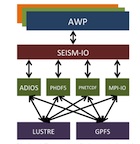Difference between revisions of "Software"
m |
|||
| (24 intermediate revisions by 3 users not shown) | |||
| Line 1: | Line 1: | ||
| − | <div id=" | + | = Software = |
| + | |||
| + | <!-- | ||
| + | <div id="tablecontent"> | ||
| + | <div id = "row"> | ||
| + | --> | ||
| − | <div id=" | + | <div id = "perscontent"> |
| + | [[Image:Awp odc.png|left|200px|link=]] | ||
| + | '''AWP-ODC'''<br /> | ||
| + | The AWP-ODC code simulates dynamic rupture and wave propagation using a staggered grid finite difference scheme. Artificial wave reflections at external boundaries are attenuated with absorbing boundary conditions or perfectly matched layers. http://hpgeoc.github.io/awp-odc-os/ | ||
| + | <br/><br/><br/><br/><br/><br><br> | ||
| − | [[Image: | + | <!--==== EDGE ====--> |
| + | [[Image:Edgepic.jpg|left|200px|link=]] | ||
| + | '''EDGE'''<br /> | ||
| + | The Extreme-scale Discontinuous Galerkin Environment (EDGE) is a solver for hyperbolic partial differential equations with emphasis on seismic simulations. EDGE targets model setups with high geometric complexities and at increasing the throughout of extreme-scale ensemble simulations. The entire software stack is tailored to the execution of “fused” simulations, which allow to study multiple model setups within one execution of the forward solver. http://dial3343.org | ||
| + | <br/><br/> | ||
| + | <!-- | ||
</div> | </div> | ||
| − | |||
| − | < | + | <div id = "right"> |
| + | --> | ||
| − | + | [[Image:io-lib-concept.jpg|left|200px|link=]] | |
| − | + | <!--==== SEISM-IO ====--> | |
| − | + | '''SEISM-IO'''<br /> | |
| − | < | + | The SEISM-IO library is designed to take up the large-scale I/O challenge across different seismic applications.The goal of this I/O library is to reduce the amount of optimization efforts and lower the barrier of parallel I/O implementation. Compared with other generalized I/O libraries, our SEISM-IO library has many specialized functions which aim at improving the programming efficiency of seismic applications, such as grid partition and buffering output. We also develop an easy-to-use application programming interface (API) for both C and Fortran language, which integrates different initialization, open, read, write and finalize processes in underlying MPI-IO, PHDF5, PnetCDF and ADIOS I/O libraries. Although designed for seismic applications, the SEISM-IO library can be used by other HPC applications based on structured meshes. https://github.com/HPGeoC/seism-io |
| − | + | <br/><br/><br/><br/><br/> | |
| − | |||
| − | < | ||
| − | |||
| − | |||
| − | </ | ||
| − | </ | ||
| + | <!-- | ||
| + | </div> | ||
</div> | </div> | ||
| − | + | --> | |
| − | + | </div> | |
| − | + | __NOTOC__ | |
| − | <div | ||
| − | |||
| − | |||
| − | |||
| − | |||
| − | |||
| − | |||
| − | |||
| − | |||
| − | |||
| − | |||
| − | |||
| − | |||
| − | |||
| − | |||
| − | |||
| − | |||
| − | |||
| − | |||
| − | |||
| − | |||
Latest revision as of 15:46, 4 May 2018
Software

AWP-ODC
The AWP-ODC code simulates dynamic rupture and wave propagation using a staggered grid finite difference scheme. Artificial wave reflections at external boundaries are attenuated with absorbing boundary conditions or perfectly matched layers. http://hpgeoc.github.io/awp-odc-os/

EDGE
The Extreme-scale Discontinuous Galerkin Environment (EDGE) is a solver for hyperbolic partial differential equations with emphasis on seismic simulations. EDGE targets model setups with high geometric complexities and at increasing the throughout of extreme-scale ensemble simulations. The entire software stack is tailored to the execution of “fused” simulations, which allow to study multiple model setups within one execution of the forward solver. http://dial3343.org

SEISM-IO
The SEISM-IO library is designed to take up the large-scale I/O challenge across different seismic applications.The goal of this I/O library is to reduce the amount of optimization efforts and lower the barrier of parallel I/O implementation. Compared with other generalized I/O libraries, our SEISM-IO library has many specialized functions which aim at improving the programming efficiency of seismic applications, such as grid partition and buffering output. We also develop an easy-to-use application programming interface (API) for both C and Fortran language, which integrates different initialization, open, read, write and finalize processes in underlying MPI-IO, PHDF5, PnetCDF and ADIOS I/O libraries. Although designed for seismic applications, the SEISM-IO library can be used by other HPC applications based on structured meshes. https://github.com/HPGeoC/seism-io